What Is a Trap Bar And Why Do You Need It?
Author:
Reviewed by:
(21 years of Oly Lifting experience)
Unlock your full potential by engaging with our experts and community! Have questions about your fitness journey or looking for expert advice on weightlifting techniques? Don’t hesitate — leave a comment below and Ihor Shymechko will provide a personalized answer and insights to help you reach your goals.
Torokhtiy is reader-supported. Some links are affiliate links, and we may earn a commission at no extra cost to you. See our disclosure page for details.
If you’ve spent any time at the gym, chances are, you’ve seen a trap bar, which is also called the hex bar. It’s hexagonal-shaped and you step into it to do lifts like deadlifts and shrugs. But do you really need it or can you do without it just fine?
Unlike a traditional straight bar, a trap bar allows you to stand inside the bar, which changes the mechanics of certain lifts. Its unique design has a lot of benefits, like less strain on your lower back, improved lifting posture, and the ability to lift heavier weights in a safer way.
It’s especially popular for deadlifts because it can make them more accessible and less intimidating for beginners, but it can still challenge experienced lifters.
Let’s go deeper into this topic!
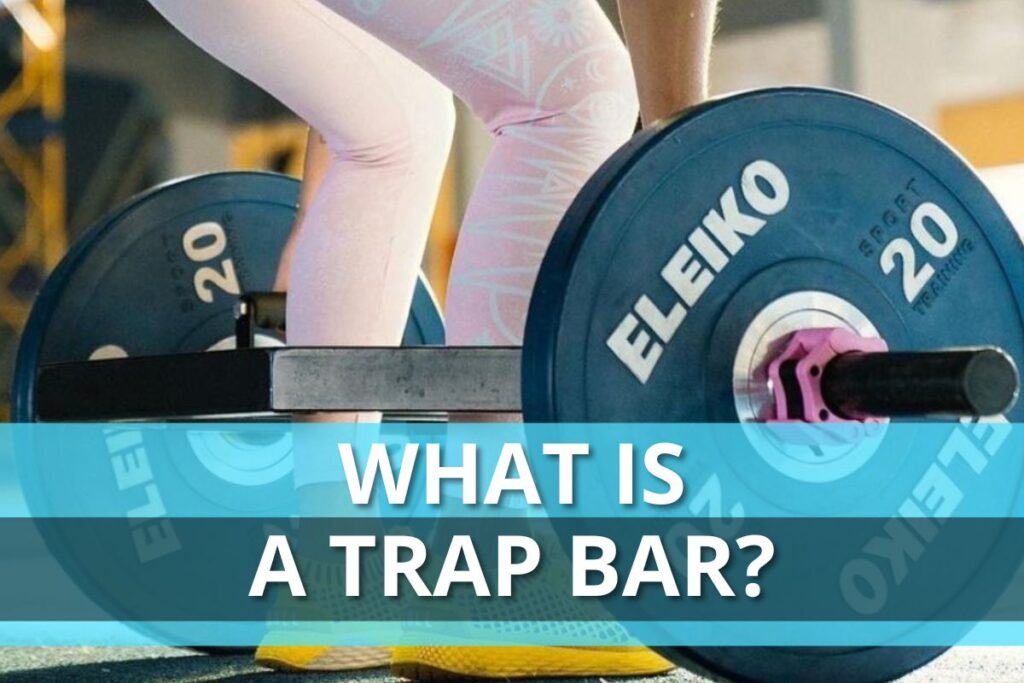
What Are Trap Bars?
A trap bar, known as a hex bar, is named for its hexagon shape, with two side-by-side sleeves for plate loading. The construction of this gear looks like this: it comes with two sets of neutral handles, one at the same level as the rest of the bar – that is low handles, and one elevated set that is high handles are placed in the middle. Due to such a design, an athlete stands in the middle of the trap bar. To perform a deadlift they should bend down to take the load.
The trap bar appeared in the ’80s when an American powerlifter Al Gerard invented it to reduce the stress on his back from performing deadlifts.
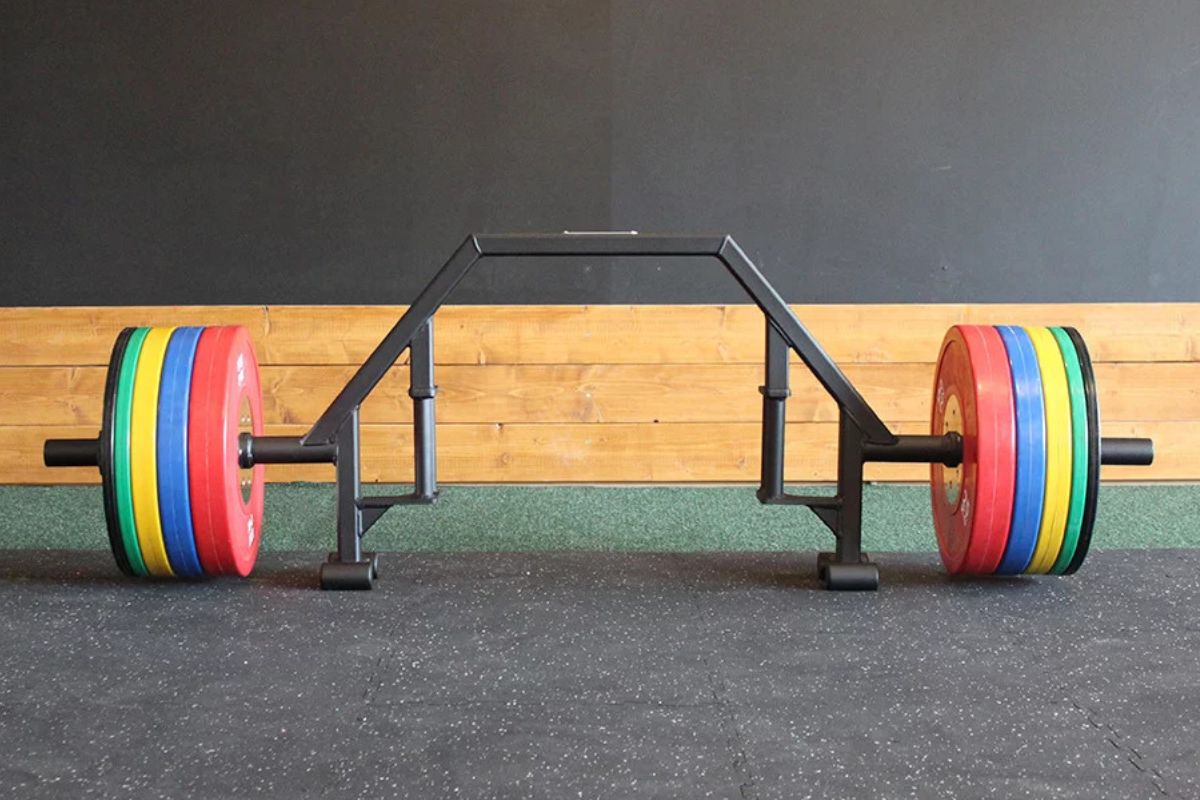
1. What the Trap Bar Is Used for and Who Does It Fit?
Besides it’s a common bar among powerlifters and weightlifters, it can help runners and other field athletes to boost their speed, while WOD devotees will be able to develop their overall power and endurance.
If you like working out a conventional deadlift and want to lift as much weight as possible, a trap bar is an outstanding alternative to a straight bar. It’s safer for your back and joints, requires less technical expertise in correct deadlift performance, and allows newbies in weight lifting to train and scale up their capabilities.
Even experienced lifters succeed in lifting more weight with a hex bar than with a standard bar. Thus, you’ll be able to promote your athletic performance.
It’s most often used for such exercises as shrugs and deadlifts by reducing the lumbar strain compared to conventional barbells. Unlike the traditional barbell, a trap bar takes away most of the load from your low back and moves it onto your legs, particularly quadriceps. So, it makes a trap bar a good tool to have a great leg development and be a safe option in case you have some back issues.
There’s a belief that a trap bar is a perfect option for beginners in lifting and those who want to improve their technique in deadlifting. It assists in mastering the correct performance and key components of lifting exercises. You’ll know how to keep the right form, i.e., how to hinge properly, how to keep your knees and control your body tightness.
Besides it, a trap bar helps to get a strong core which is essential in working out with heavier weights.
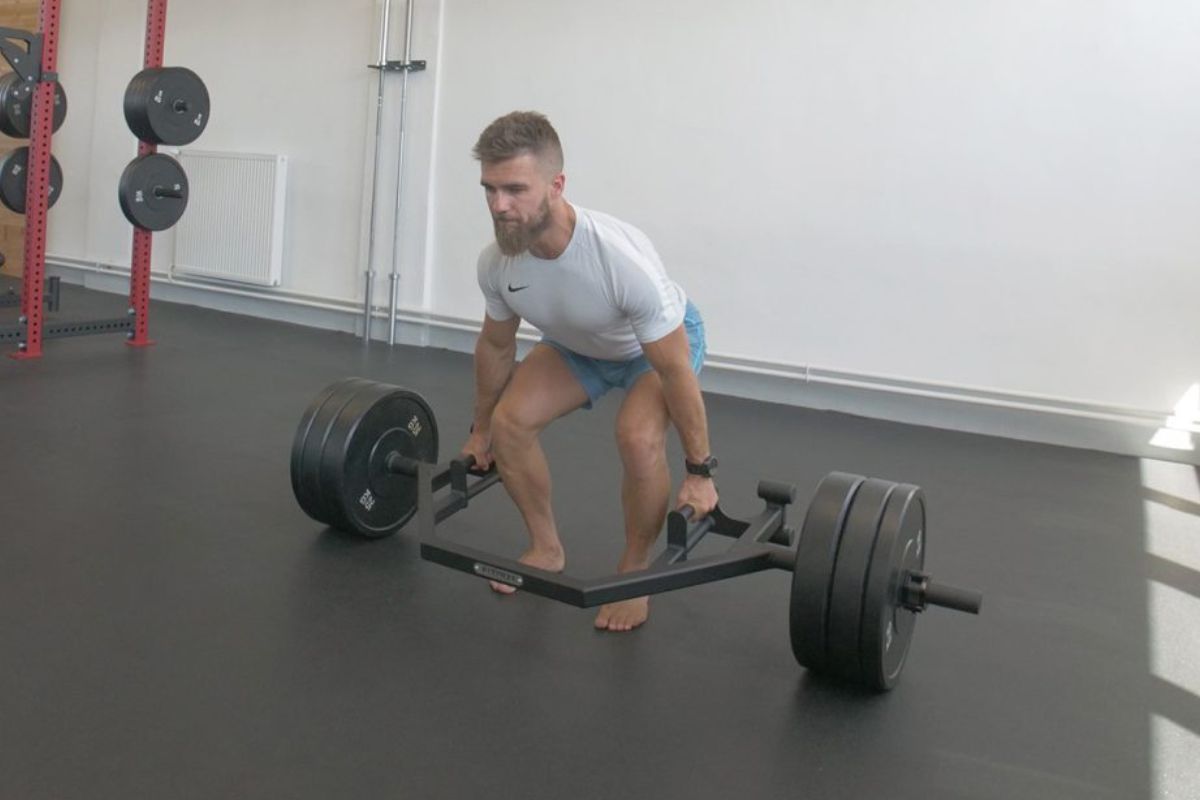
2. What Muscles Are Activated During the Trap Bar Workout?
To use it, you stand in the middle and grip the side handles. Pulling from the floor involves the hamstring, hip, and back muscles by strengthening them, and promotes the development of the posterior chain.
The trap bar enhances your general explosiveness which can be useful in plyometrics, decreases back pain, and corrects poor posture. By the way, the trap bar deadlift incorporates hamstrings, glutes, quads, lower back, lats, and traps, and also improves your grip strength.
3. Trap Bar Technique
Speaking about the technique of the trap bar deadlift, it roughly resembles several separate motions like deadlifting and squatting. The reason is that when bending down to pull the weight, your knees can come forward, which looks like squat biomechanics.
Although, it includes hip-hinge motion that activates your posterior chain (erector spinae, glutes, and hamstrings) which pulls your hips forward during extension. At the same time, you can include more quadriceps if you choose a deadlift performance technique.
Let’s outline key points of the trap bar deadlift technique:
- When standing you should move your buttocks back until the shoulders are placed over the feet. Keep your back tight and your legs loaded.
- Here you have two variants of the legs position. The first is to keep shins vertical which will involve hamstrings and hip flexion dominantly. The second is to activate more quads, so your knees come forward. Performing this way, you’ll mimic the biomechanics of the squat.
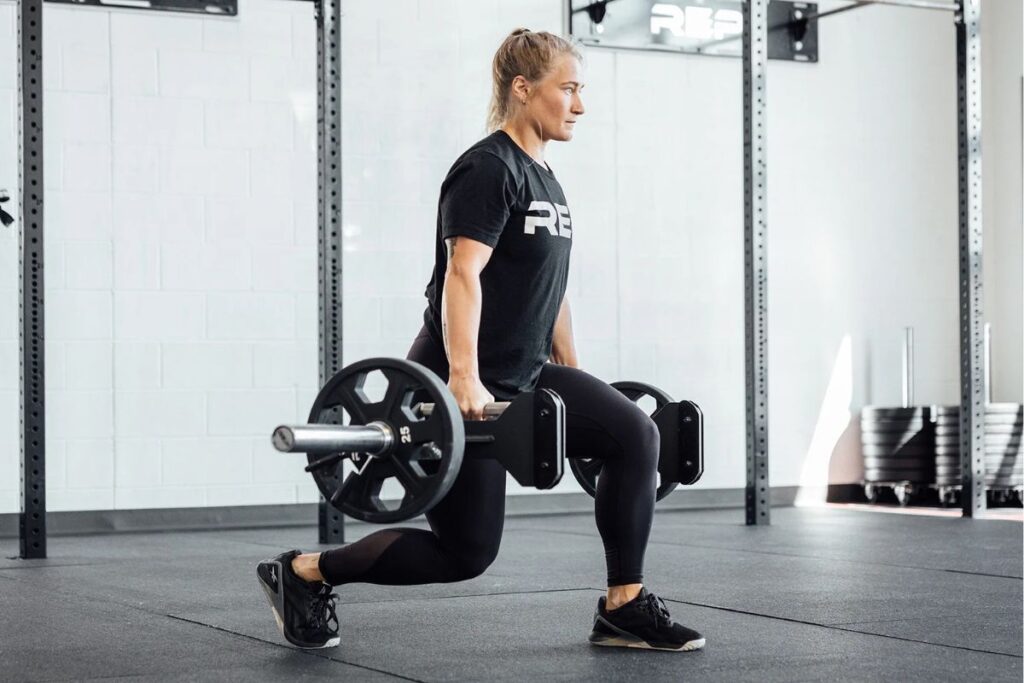
Why Buy a Trap Bar?
1. Building Strong and Lifted Buttocks
Working out with a trap bar involves your body muscles in different ways by executing various positions that slightly differ from a standard barbell. Compared to a straight barbell that activates more back muscles, a trap bar deadlift focuses on your leg muscles such as the glutes, quadriceps, and hamstrings. That means you’ll feel more tension in your buttocks which makes these muscles grow.
Tips From the Champ
Like a standard barbell, hexagon bars have their specific knurling pattern on the grip for better handling during weight training. For instance, the diamond patch aims to provide extra grip and good friction, so your palms or weightlifting gloves won’t slip on the bar. Such bars are designed with aggressive tread for maximum grip and fit best experienced lifters. However, newcomers can find such a pattern a bit abrasive for their hands. Some trap bars come with moderate knurling and offer a bit lower tackiness.
Olympic Weightlifting Champion
2. Increasing Power and Stamina
A trap or hex bar got its name from the specific construction – it looks like a hexagon within the center that comes with a step-in design. And it aims to train trapezius muscles, that’s why it’s a trap bar. A lifter stands inside this hexagon by getting enough space to pull and lift the bar without hassle.
A trap bar will come in handy if you do plyometrics exercises since this gear can enhance strength and power. Generally, a trap bar deadlift involves pulling from inside the bar that enables activation of dominantly larger leg muscles, i.e., quadriceps, hamstrings, and glutes. So, if you want to gain strength, a combination of plyo exercises (box, squat jumps) and trap bar deadlifts will significantly build lean muscle mass.
3. Decreasing Lower-Back Pain
If you have some pain in the lumbar area, training with a trap bar will mitigate your problem. Due to the upright position, this bar will limit the stress and take off the shearing force on your back, so all the tension goes to the legs.
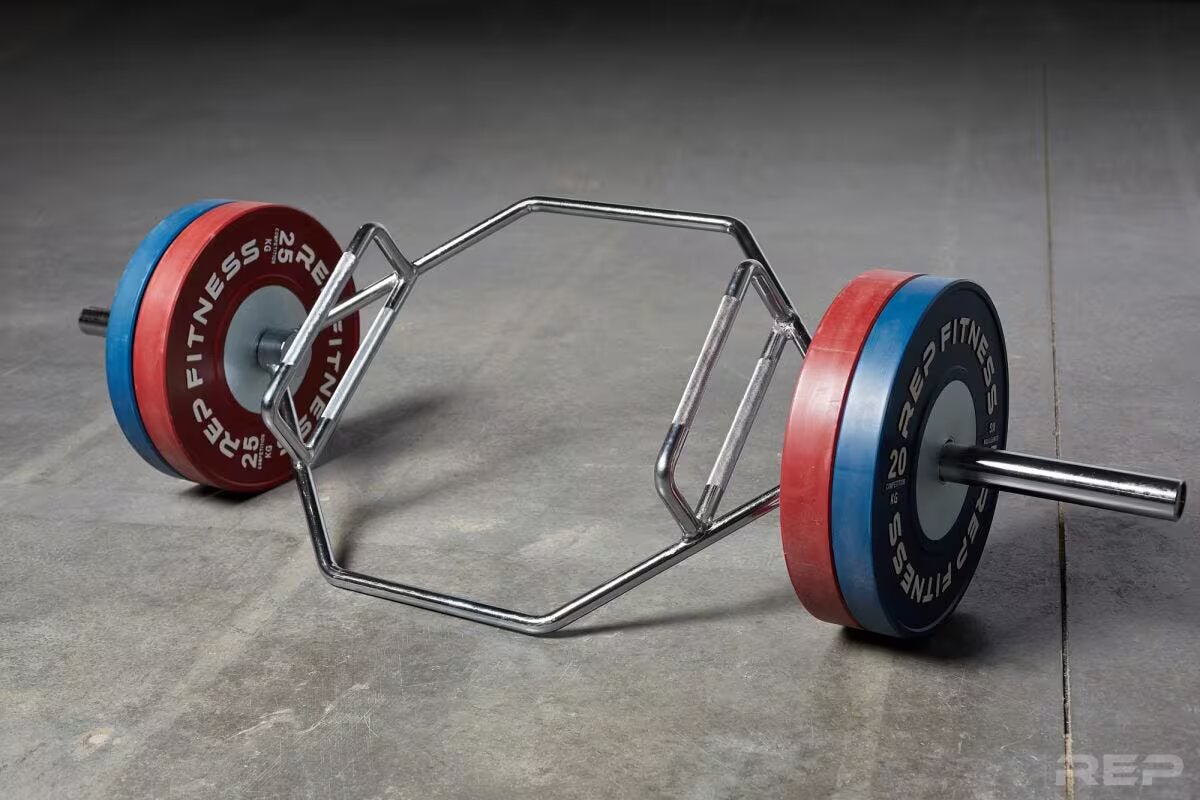
4. Developing a Range of Motion
You can find trap bars with a second handle set, which makes this gear fitting for people with limited mobility in the lower body and poor range of motion. Such an option enables an athlete to start weight training from a higher starting position. The second set of handles may become helpful for those with tight hamstring muscles, or who have some hip or knee issues.
Thanks to the possibility to vary handles and your grip, there’s a wide range of exercises: improve standard motions of deadlifts and squats, shrugs, farmer walks and carries, deep push-ups, mid-thigh pulls, overhead presses, chest presses, and so on.
Depending on the bar design and its size, it’s possible also to do walking lunges or unilateral squats (these options are possible with the open frame), without worrying to hit the bar with your knees.
5. Providing Gradual Progress With No Harm
A trap bar structure assists with the gradual lifting of heavy weights with minimal strain possibility, unlike training with a straight bar. So, a lifter can overcome a power plateau and move forward to new lifting goals. You’ll also learn how to distribute the body weight evenly throughout the training session.
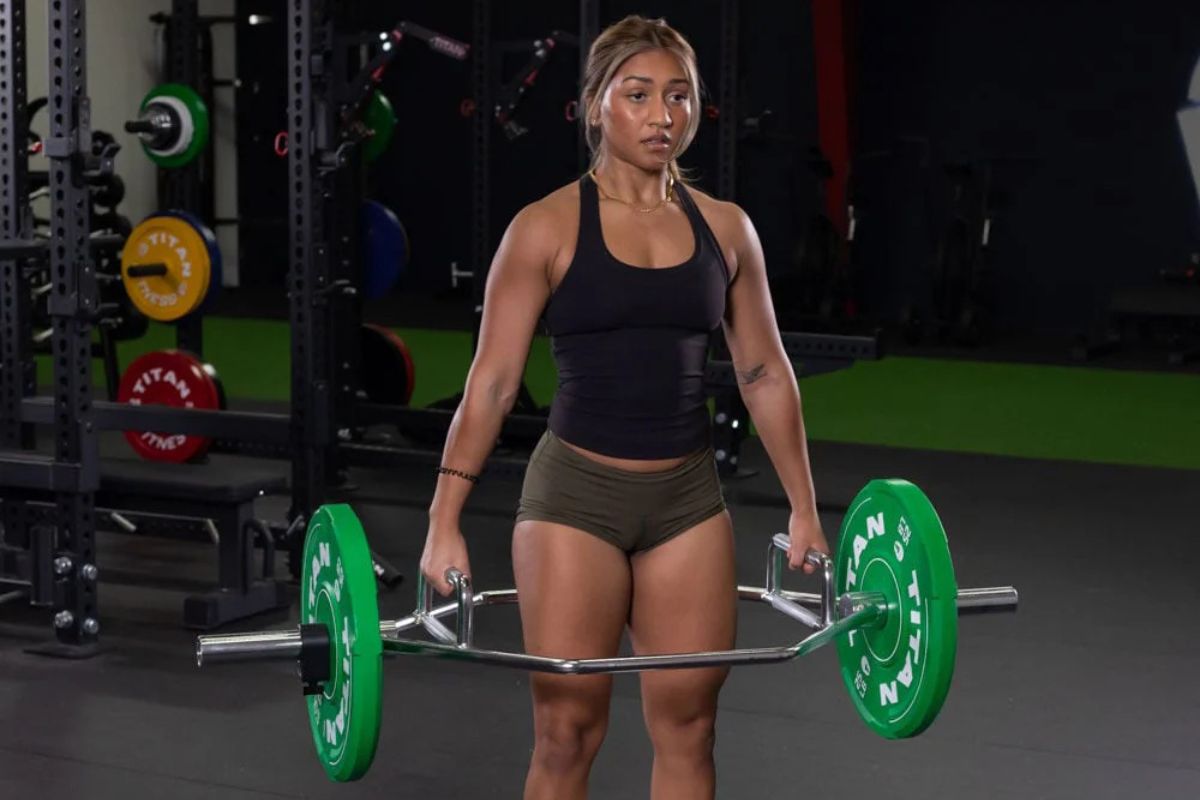
6. Enabling You to Get Prepared for Greater Loads
The vast majority of athletes confess that they succeed in lifting heavier weights with a trap bar, than with a straight one. The difference is usually up to 5–10% heavier weight with the trap bar. This is due to the option of two handles – low and high grip handles. So, you can perform better with the latter option overally and do heavier deadlifts.
Consequently, greater weights will place more load on the lower body leading to muscle development in further. This can matter to functional fitness sportsmen who lean on long and intensive WODs.
The studies showed the difference in the kinematics of the straight barbell deadlift and hexagonal barbell deadlift by indicating that the increased mechanical stimulus with the trap barbell brings a more effective exercise than with a standard barbell.
The investigation also displayed that male lifters succeeded to perform their 1RM (repetition maximum) with a result of 265 ± 41 kg with a trap bar deadlift compared to 245 ± 39 kg with a conventional bar.
As a result, the study indicated a significantly greater peak of force, velocity, and power that were produced during the hex bar deadlift, compared to the standard bar. Such outcomes became possible due to the special design of a trap bar, which changes the resistance at the joints and knees and lowers the peak moment in the lower back, hips, and ankles.
Additionally, you won’t feel degradation when doing a regular deadlift set with a hex bar, since your back doesn’t receive the tension as when training with a standard bar.
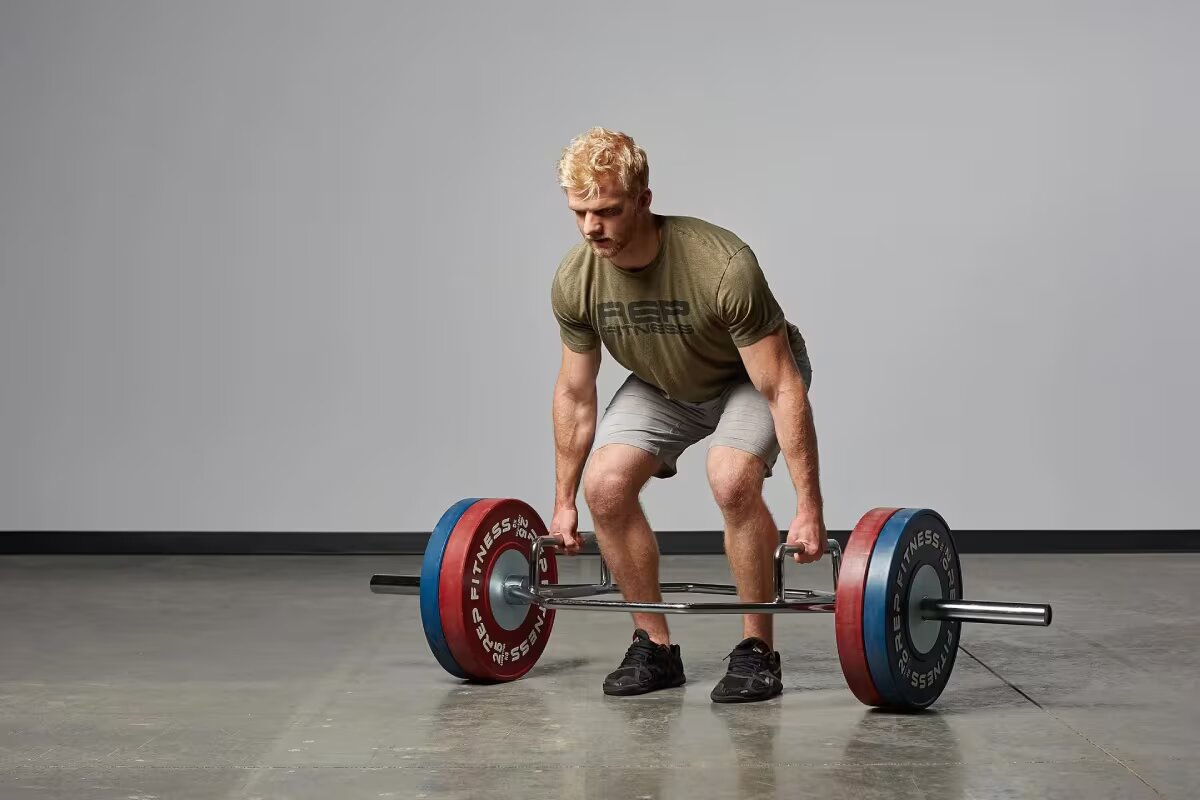
How to Pick a Trap Bar?
1. Knurling
Like a standard barbell, hexagon bars have their specific knurling pattern on the grip for better handling during weight training. For instance, the diamond patch aims to provide extra grip and good friction, so your palms or weightlifting gloves won’t slip on the bar.
Such bars are designed with aggressive tread for maximum grip and fit best experienced lifters. However, newcomers can find such a pattern a bit abrasive for their hands. Some trap bars come with moderate knurling and offer a bit lower tackiness.
2. Weight Capacity
When looking for a trap bar to upgrade your strength and lifting capabilities, it’s better to consider equipment with a larger weight capacity in order to be able to load it with lots of plates. Generally, trap bars can withstand from 500 lb to 1000 lb. Thus, mind your workout goals and the way you plan to develop your power potential.
Consider the fact that hex bars can be utilized for diverse exercises and you’d better choose those gear with high potential, meaning you can apply it for multiple lifts and increase your lifting weight gradually.
3. Interior Dimensions and Design
The most widespread interior diameter, that is the distance between the handles, is around 25-30″. This is a standard dimension that doesn’t constrict an athlete while performing exercises. Also, you can find a walkthrough design that removes one half of the hexagon by opening the front or back part of it.
You should take into account the general bar length, as well as sleeve dimensions, including diameter to know whether you’ll be able to load it with several plates, its compatibility with Olympic plates, etc. In case you already have a home gym and have enough space for additional training equipment, check which trap bars can be racked on a power rack.
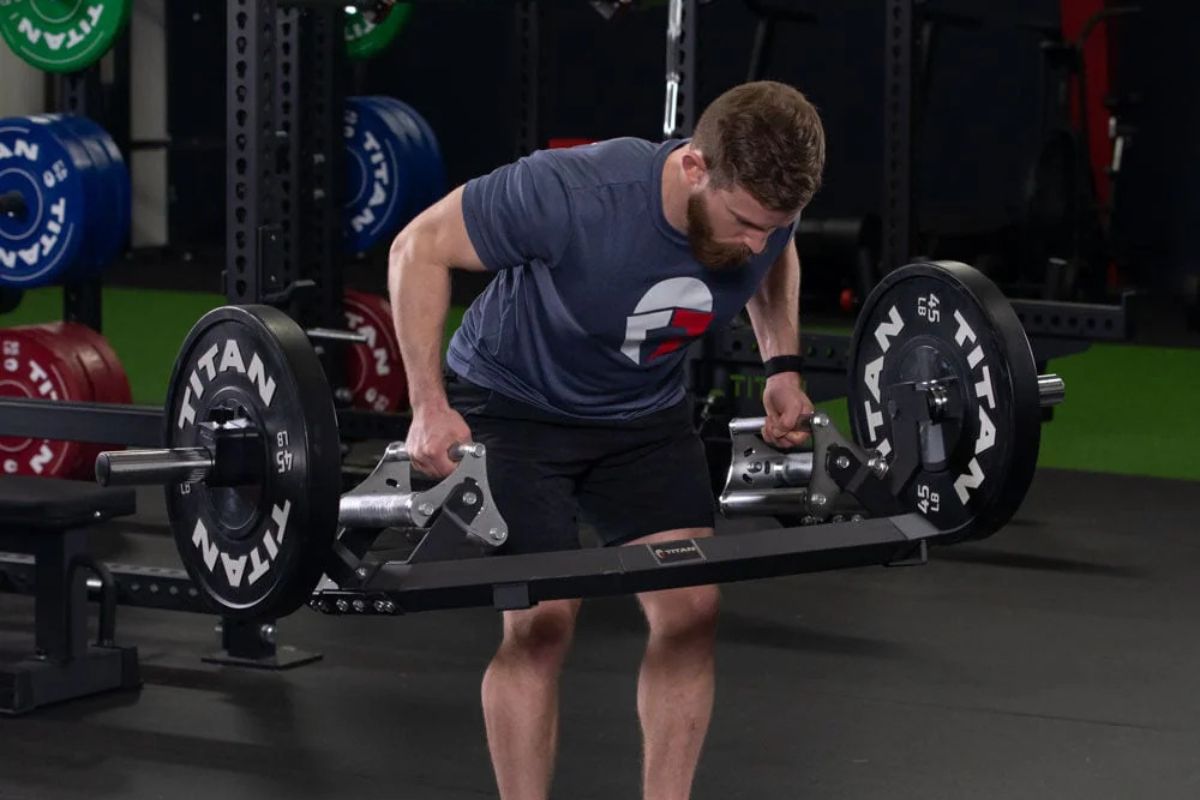
4. Construction
You’ll find two of the most popular shapes: a standard hexagonal construction and an open-back hex bar design. The first type is more fitting for starters in deadlifting who want to improve their technique in this exercise. The second design is more versatile, brings more mobility to an athlete, and generally, is better for more experienced guys.
It needs to be mentioned that an open trap bar is a better option for taller lifters who want to keep a flat back in deep angles. Also, it provides even more space than a simple hexagonal bar due to the open side, so those who have a poor range of motion can feel more freedom and have more space to lean forward and pull the weights.
Both options keep well the weight directly in line with an athlete’s center of gravity, which lumbar spine strain and you can position in the most fitting way to lift more weight while boosting your gains.
5. Handle Placement
There are trap bars with one and two-handle sets that just diversify your training and expand your range of motion. The handles shouldn’t restrict your movements and shouldn’t be placed too wide. They should provide an athlete with maximum comfort and stability while lifting heavy weights.
REP Fitness Trap Bar
The bar has two options of handles: the standard and the raised ones which vouch for trap bar versatility. The knurled 0.9″ handles have medium-depth knurling that won’t tear up your hands, but still gives a good grip.
The REP trap bar frame is chrome-coated, guarantees good oxidation resistance, making it look solid over time unlike with the powder coating, and has long 16″ sleeves out of the rib. You can use this gear with standard 2″ diameter center hole plates.
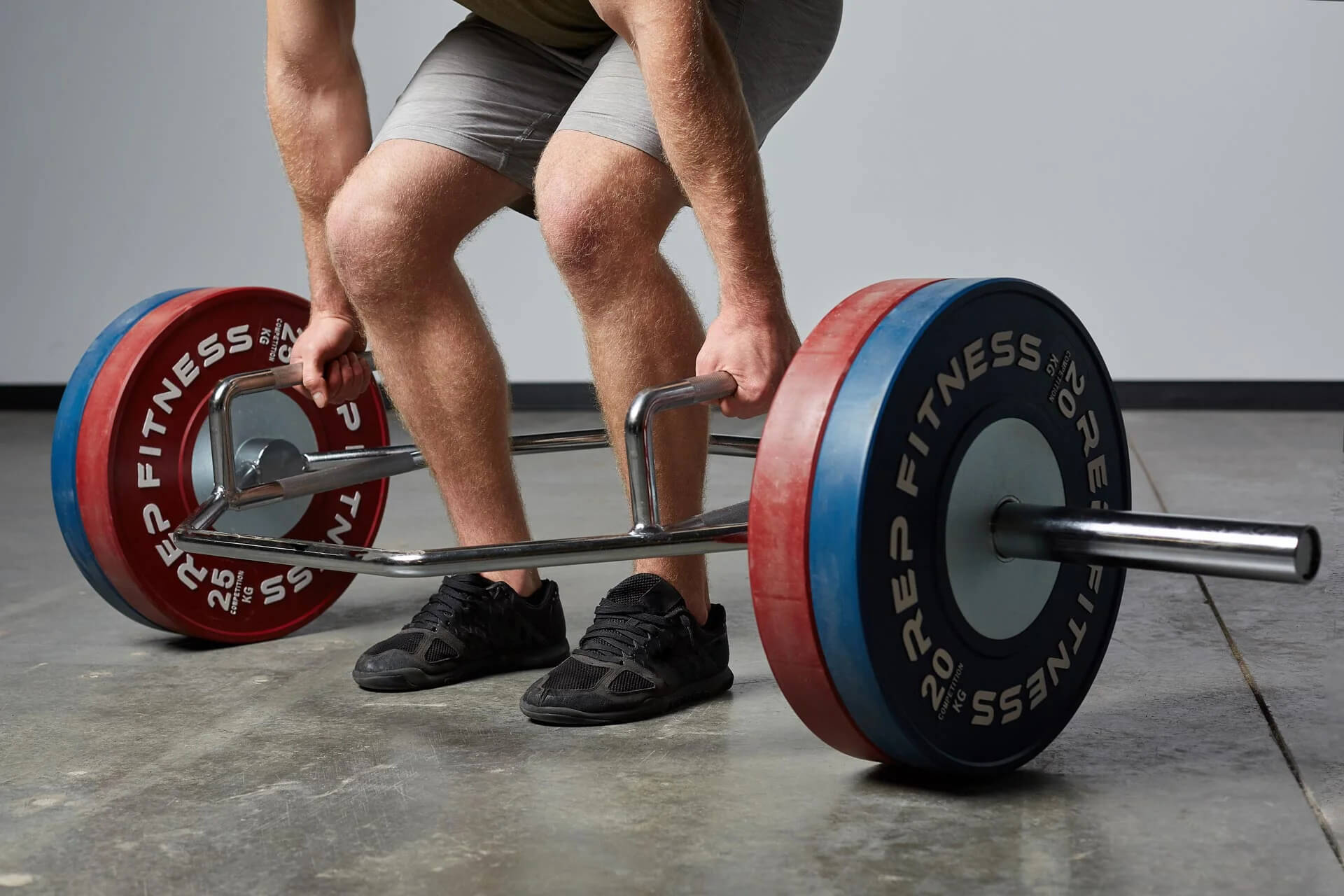
It’s a perfect option for beginners in weight training, people rehabbing from injuries, and sportsmen with limited mobility. It’ll be easier to learn the proper pulling technique because the barpath is restricted by its hexagonal shape and inside placement brings more stability.
Difference Between a Trap Bar and a Standard Barbell
1. Centered Weight Distribution
You can transfer the weight to the center while trap bar deadlift performance. Unlike with a straight barbell, when you hold the weight in front of you, with a trap bar, the weight you lift is close to your gravity center which is better for your lower back. When working out with a straight barbell, you hold it in front of you. This position requires keeping the bar tightly to your shins and extending forward to grab it and pulling up toward you.
2. Activating Various Muscles
Despite the fact that you load both barbells equally, you’ll be able to lift more weight with a trap bar because the hip hinge and knee movements are involved greatly. Consequently, different muscle groups will be activated: quads are better worked out with trap bar training, while the hamstring and spinal erector are most activated with a straight bar. Also, you’ll succeed to load more thanks to the optional high handles.
3. Mobility Level
You’ll get a shorter range of motion when training with a trap bar because of the raised handles. You don’t need to bend down more to grab them like with a standard bar. But, generally, a larger range of motion is a better movement that makes a usual deadlift better than a trap bar one.
On the other hand, a shorter range of motion enables the majority to get into position and lift easier, and it provides less hip flexion due to the handles out of the side of the bar. Also, the weight pulls you down and to the center, rather than forward only.
4. Body Positioning
As we already mentioned, you can keep your trunk vertically when working out with a trap bar that limits your ROM a bit. At the same time, you don’t need to bend over to take the bar thanks to the raised handles. The advantage of such body positioning is that you won’t suffer from the spine and lower back load. Additionally, with a trap bar, you can grip it neutrally, without using a wrist strap to lift heavier loads.
5. Muscles Work
In general, a deadlift with a traditional or trap bar focuses on the same muscle groups. But, when pulling a barbell, you involve dominantly glutes and hamstrings, while being also glutes and hamstring-focused, a trap bar deadlift brings more work to the quadriceps. During the barbell deadlift, your body goes lower.
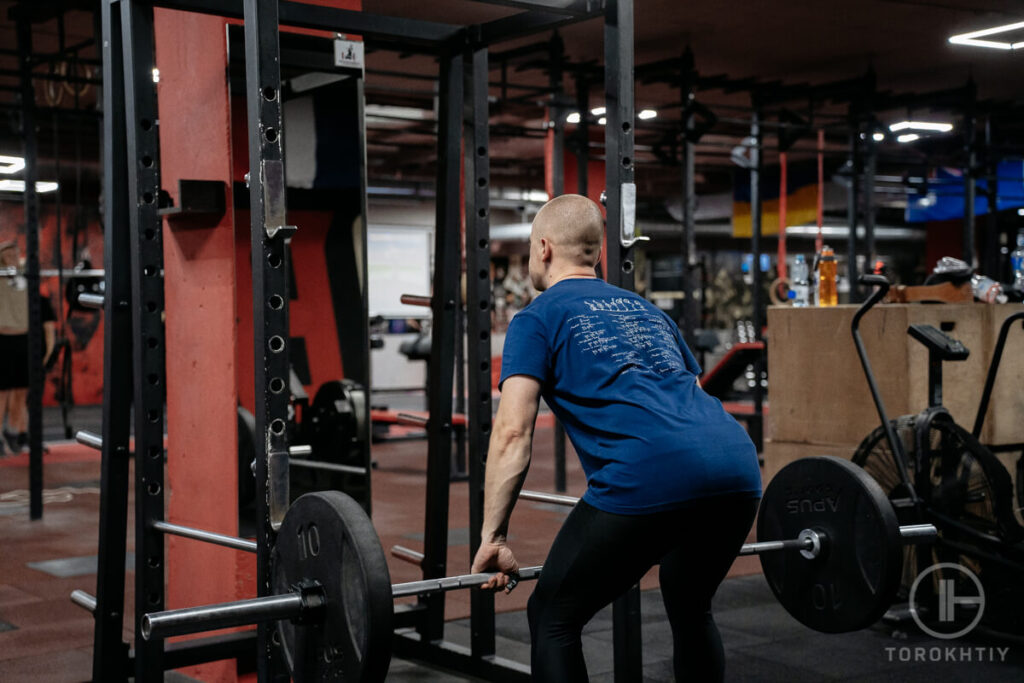
FAQ
Are Trap Bars Any Good?
With a trap bar, you have a great variety of motion patterns to work out, for instance, squatting, hinging, lunging, pushing, pulling, and carrying weight. A trap bar keeps your spine properly and also limits your ability to hyperextend at the top of a deadlift by locating all the loaded weight on your gravity center, but not in front of you.
What Trap Bar Does the Army Use?
According to the ACFT (Army Combat Fitness Test), a hex bar is utilized to assess a soldier’s upper-body pulling strength, core stability, and overall endurance and conditioning, and a soldier must deadlift 340 lb total to get 100 points to the max. The reason for this choice is obvious: a trap bar isn’t so demanding to the deadlift technique and fits more beginners.
Since they need to perform a 3-repetition maximum deadlift, a hex bar is the best option in this case because it doesn’t affect badly the back muscles and spinal cord generally. So, it mitigates and lowers the possibility of serious injuries while pulling heavy plates.
Is a Trap Bar Safer Than a Deadlift Bar?
Yes, a trap bar workout brings a milder impact on your back and knees. This special bar is designed to build explosive power by lowering the possibility of injuries. The main reason is that a weight is centered equally on your body by ensuring a balanced position.
It’s also a well-known fact that a hexagonal bar reduces the stress on the lumbar area and is more a quadriceps-oriented movement. Additionally, a trap bar is more efficient in facilitating force production and growing explosive strength for performing deadlifts.
Conclusion
If you include a trap bar into your training routine, you’re in for a lot of benefits. Its design will help reduce lower back strain, which will make lifts like deadlifts safer and more accessible. This can be especially good for beginners who might struggle with traditional deadlifts that are done with straight barbells.
The trap bar also promotes better posture and it can allow you to lift heavier weights because of the balanced weight distribution. Its ability to make challenging lifts more approachable while still giving you an intense workout can do wonders for your fitness goals
REP Fitness Trap Bar is one you’ll absolutely love. It will bring you an effective power workout, even with no sufficient level of proper lifting technique.
This highly functional, versatile gear of premium quality will spice up your training without compromising your drilling in quality and efficiency. You’ll learn proper deadlift performance by getting a better physical form and having more natural body positioning. With this trap bar, you’ll get the load you want to lift centralized and balanced with your body center.
That’s it from us, now we want to hear what you think! Do you use a trap bar? If you do, what do you like most about it? If you don’t, what’s stopping you? Have you tried the trap bar we recommend or do you have another one that you love?
Leave any thoughts, tips, tricks, and anything else you can think of in the comment section below!
Also read:
- Best Barbells for Functional Fitness
- Trap Bar Deadlift Benefits
- Trap Bar vs Barbell Deadlift
- How Much Does a Hex Bar Weigh
- Types Of Weight Plates
- Hex Bar Exercises
- Portable Landmine Attachment
- Dimensions of Olympic Barbell
- How to Clean a Rusty Barbell
References:
- 13 benefits of an open trap bar // Repfitness: https://repfitness.com/blogs /training/13-benefits-of-an-open-trap-bar
- Effect of a Hexagonal Barbell on the Mechanical Demand of Deadlift Performance // Ncbi: https://pubmed.ncbi.nlm.nih.gov/29910442/
- A biomechanical analysis of straight and hexagonal barbell deadlifts using submaximal loads // Ncbi: https://pubmed.ncbi.nlm.nih.gov/21659894/
- Relationships Between Hex Bar Deadlift One-Repetition Maximum and Maximal Isometric Pulls // Ncbi: https://pubmed.ncbi.nlm.nih.gov/36895846/
- An Examination of Muscle Activation and Power Characteristics While Performing the Deadlift Exercise With Straight and Hexagonal Barbells // Ncbi: https://pubmed.ncbi.nlm.nih.gov/26840440/
- Effect of an Exercise Program That Includes Deadlifts on Low Back Pain // Ncbi: https://pubmed.ncbi.nlm.nih.gov/33626500/
- Photos are made by REP Fitness, Titan Fitness, Rogue Fitness, Fitron, and and Torokhtiy Media Team.
Why Trust Us?
With over 20 years in Olympic weightlifting, strength training, nutrition coaching, and general fitness our team does its best to provide the audience with ultimate support and meet the needs and requirements of advanced athletes and professional lifters, as well as people who strive to open new opportunities and develop their physical capabilities with us.
By trusting the recommendations of our certified experts in coaching, nutrition, and sports training programming, as well as scientific consultants, and physiotherapists, we provide you with thorough, well-considered, and scientifically proven content. All the information given in the articles concerning workout programming, separate exercises, and athletic performance, in general, is based on verified data.
The product testing process is described in more detail here.
Author: Ihor Shymechko
Pro Olympic Weightlifter, Coach
Best Results: Snatch – 208 kg,
C&J – 240 kg
Ihor has been a professional weightlifter since 1996, boasting over two decades of competition experience. His notable achievements include clinching the European Championship in 2009 and securing a silver medal in the 105kg division at the Senior World Championships in 2011. Ihor represented his country in the 2008, 2012, and 2016 Summer Olympics. After retiring from competitive weightlifting, he transitioned to coaching, leveraging his vast experience to guide athletes who now compete on both national and international stages.
Reviewed by: Oleksiy Torokhtiy
Olympic Weightlifting Champion, PhD in Sport Science
Best Results: Snatch – 200 kg,
C&J – 240 kg
Oleksiy Torokhtiy is a professional athlete boasting 20 years of experience in Olympic weightlifting. With multiple European and World titles under his belt, he has showcased his prowess in two Olympic Games (Beijing 2008 and London 2012). Upon concluding his illustrious career, Oleksiy dedicated himself to coaching. By 2022, he had conducted over 200 weightlifting seminars worldwide. He is the visionary behind an international sportswear and accessories brand known for its motto, “Warm Body Cold Mind.” Additionally, he is an esteemed author and the creator of a series of training programs and eBooks.





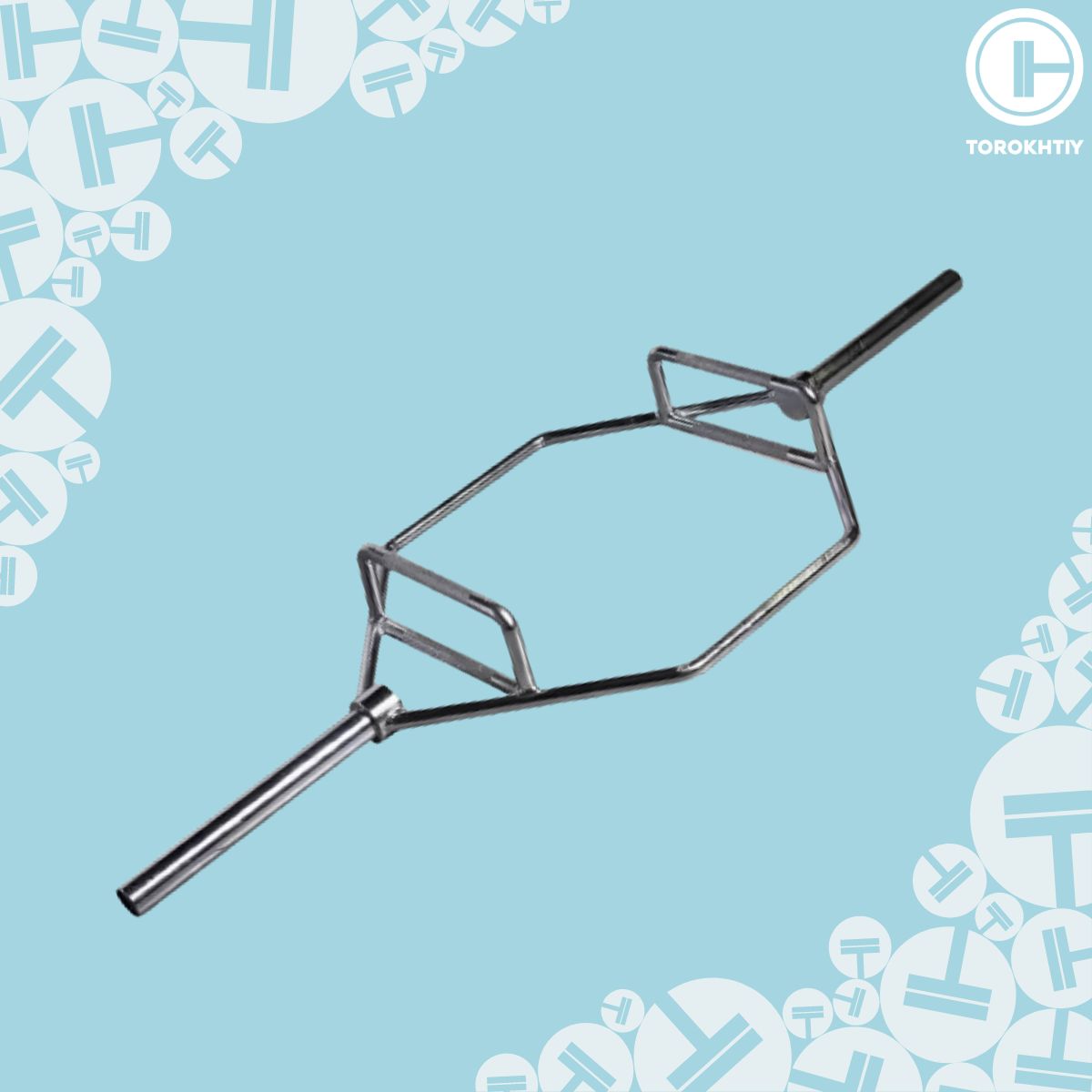
Still have questions after reading our article? Unlock your full potential by engaging with our experts and community! Don’t hesitate — leave a comment below and Ihor Shymechko will provide a personalized answer and insights to help you reach your goals.